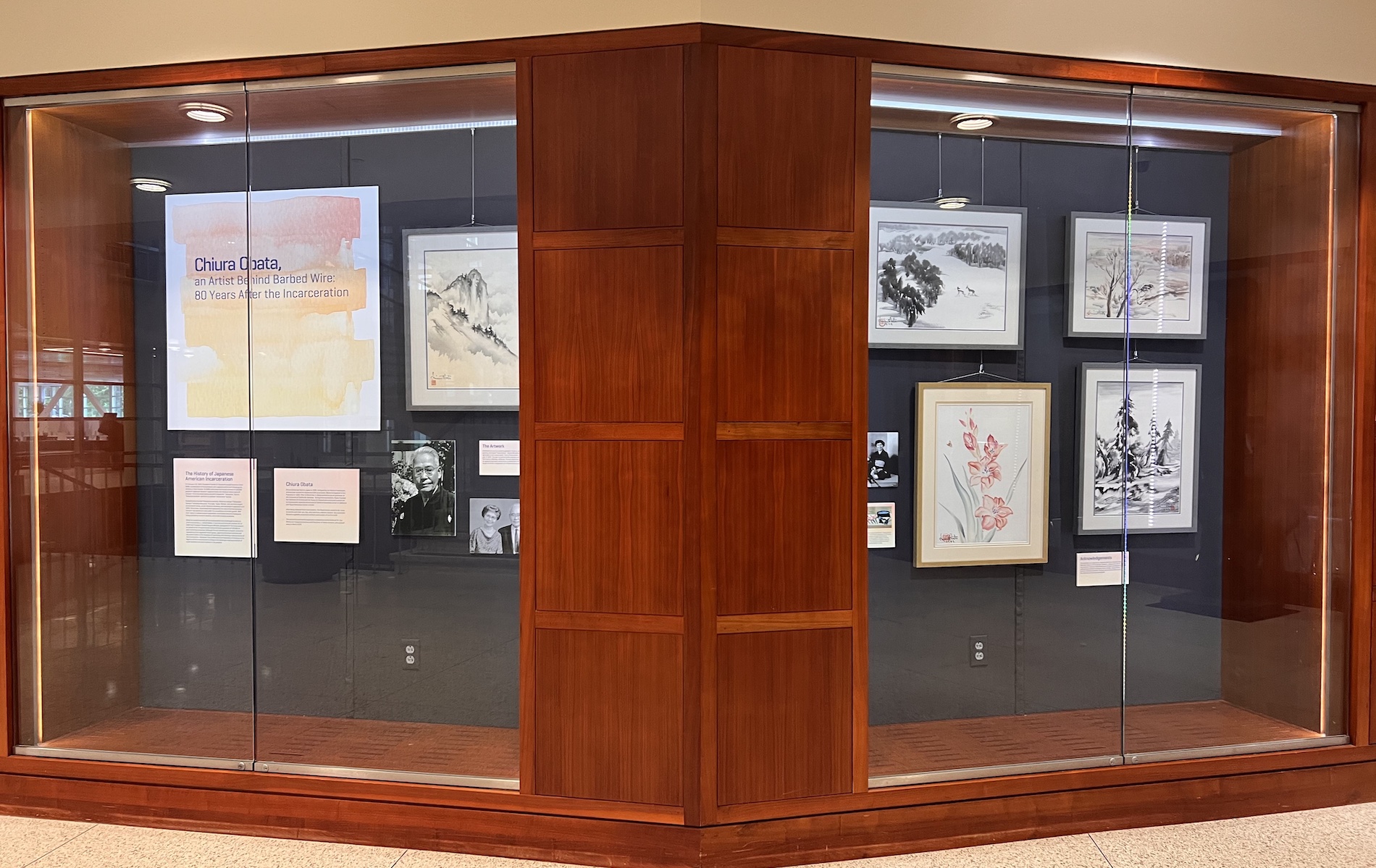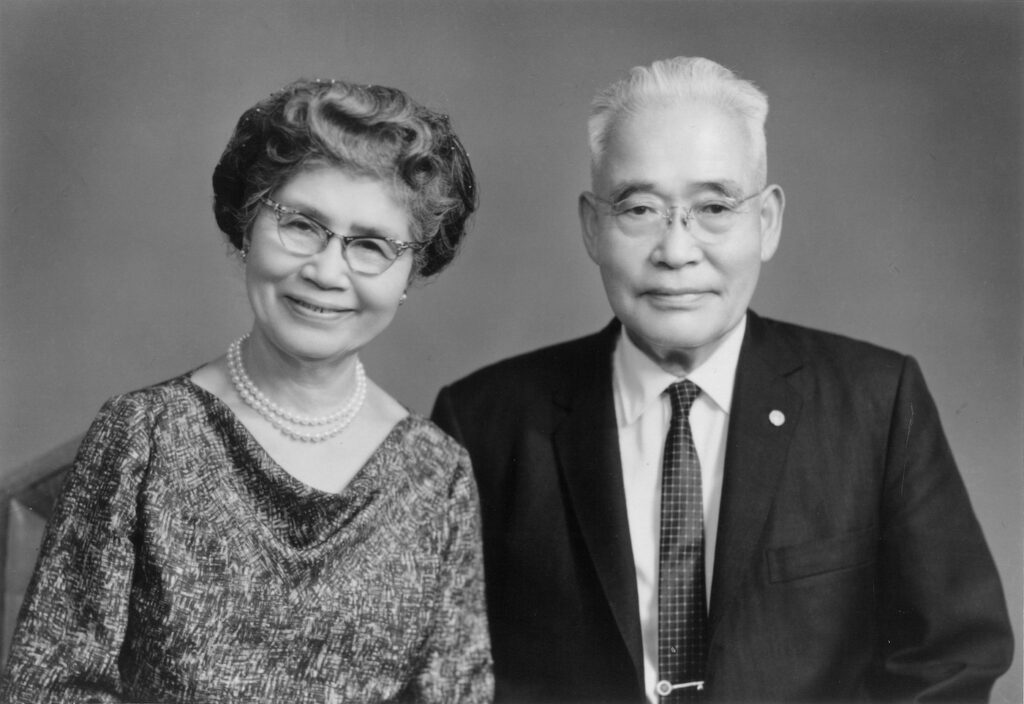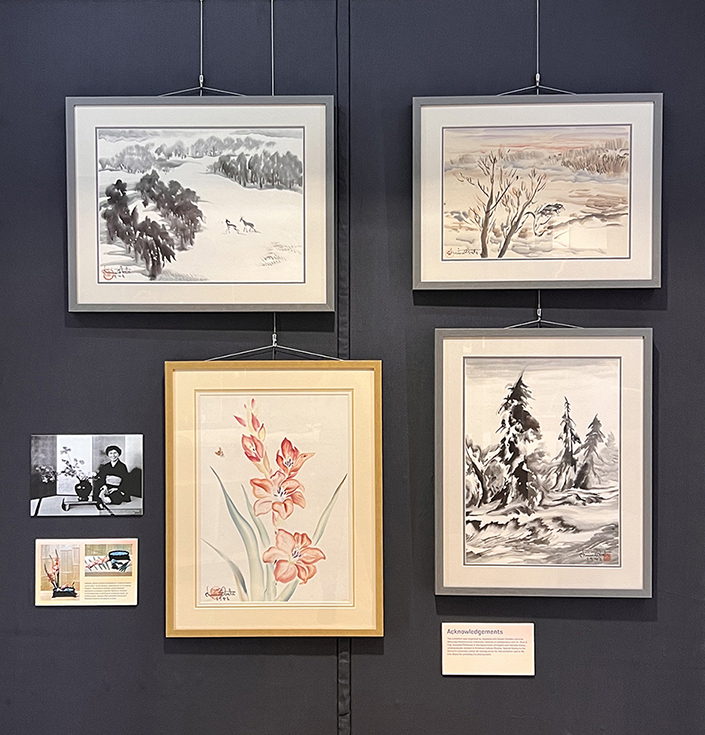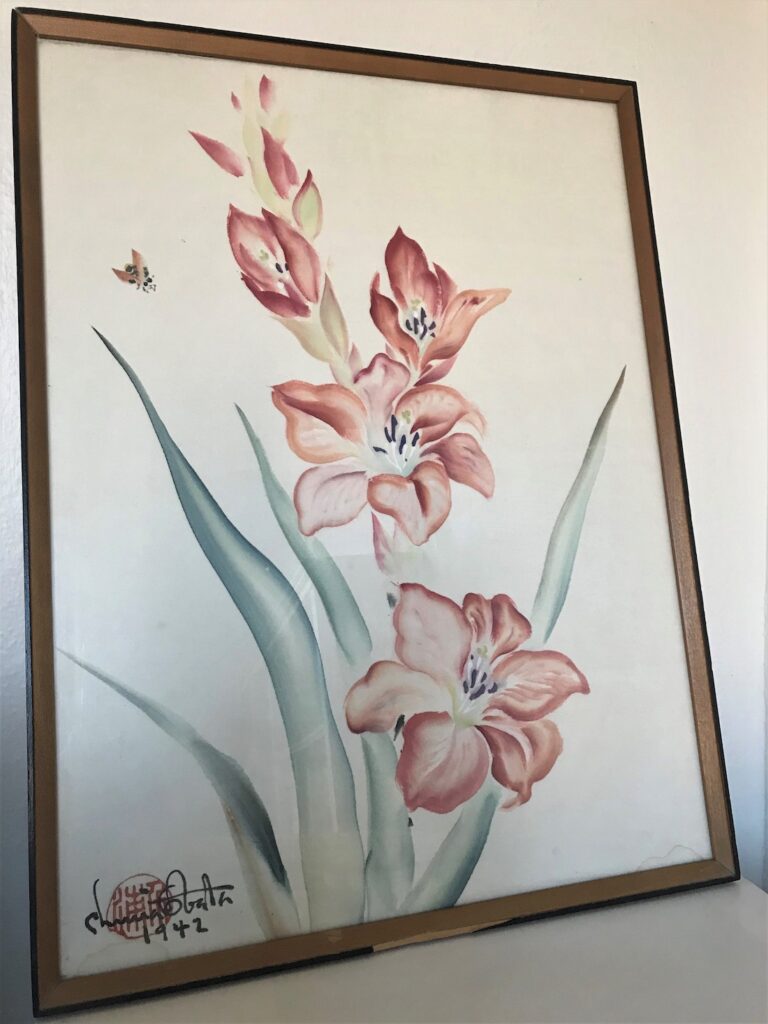
Art in Dark Times: Japanese American Artist Chiura Obata
A new exhibition at John M. Olin Library, Chiura Obata, an Artist Behind Barbed Wire: 80 Years After the Incarceration, highlights the artist’s paintings from 1942—the year President Roosevelt’s Executive Order 9066 forced the Obata family and more than one hundred twenty thousand West Coast Japanese Americans, including residents in Hawaii, into internment camps called “relocation centers,” scattered across remote parts of the Western United States.
Born in Japan, Obata (1885-1975) is hailed as one of great American landscape painters of the last century for recreating the natural environs of California on his canvas. On view in Olin Library is his signature Japanese classical style sumi-e, a form of calligraphic brush and ink strokes found in Japanese and Chinese art.
The exhibition presents five paintings from the Danforth University Center, which come from the Obata family. One of the paintings showcases his mastery in capturing Ikebana flower arrangements, an art form in which his wife Haruko excelled. The paintings largely depict the theme of “Great Nature,” which occupies a central place in all of Obata’s paintings.

Obata and his family were detained at the Tanforan (California) and Topaz (Utah) incarceration camps. He started an art school at the camps, teaching other detainees and creating a large body of artwork during his imprisonment. Upon release in 1943, he joined his son Gyo Obata in St. Louis, a Washington University student of architecture, who would go on to become a globally famed architect. Obata eventually returned to California to resume his teaching career as an art professor at UC-Berkeley.
The exhibition was organized by Japanese and Korean Studies Librarian Mitsu Nakamura. In an interview, Nakamura discusses the significance of Obata’s legacy and his art collection at Washington University.

How did the idea for the Obata exhibition take shape?
Mitsu: Just before COVID-19 erupted, I received an email from a staff member in the Danforth University Center (DUC) inviting me to look at a photo album from Japan that had been stored in the Stix House. The email ended with the mention of an Obata painting at the DUC. I was very curious. At that time, I knew very little about the legendary artist and his family connection with WashU. It turned out to be the painting of the bee approaching the gladiolus flowers, which is now a part of the exhibition.
I had the painting transported to the East Asian Library and began to search for a place to hang it permanently. I also learned that the DUC had four more Obata paintings in a conference room. I noticed that three of five paintings were produced in 1942, coincidentally the same year that the Obata family was forced to leave everything behind and move to an internment camp. This year, 2022, also marks the eightieth year since the establishment of Order 9066 directing incarceration of people of Japanese ancestry. I had this idea for an exhibition that marks the memory of the event, a way to remember the calamities and cruelties these people had to suffer.
How do you think audiences today should understand the significance of the Obata exhibition and his art?
Mitsu: Despite its association with his incarceration, Obata’s art contains positive messages and images. His remarkable story and paintings encouraged and motivated me personally during the hardships of the Covid-19 pandemic. For this reason, I want to make Obata’s art recognizable to wider audiences. Obata had to leave everything behind when he was forced to evacuate, but despite the losses he continued to paint and teach art in the prison camps. He collaborated with his wife Haruko, an Ikebana artist, to teach art classes. Even at the darkest hour he kept teaching about art.
How did Washington University acquire the Obata paintings that are on display in the exhibition?
Mitsu: As you know, Obata’s son Gyo transferred to WashU from the University of California-Berkeley because WashU offered admission to about thirty Japanese-American students and he was one of them. With the help of sponsorship from local churches, the Obata family rejoined their son in St. Louis. (Obata and his family moved from the Topaz internment camp in Utah to Webster Groves in St. Louis and stayed there from 1943 to ‘45.) That was the beginning of the connection between the Obata family and St. Louis and WashU.
In the early 1970s, we assume Gyo donated several of his father’s artworks to the Stix House at WashU (opened in 1909, the Stix House has been used over the years to support international students and student learning around topics of international interest).
Unfortunately, at WashU there is no extant record of the transfer of his paintings. Obata’s granddaughter, Kiku Obata, has been very helpful and has provided the family pictures for the exhibition. Furthermore, it is saddening that Gyo Obata just passed away earlier this year. Gyo was one of our beloved and respected alumni, and this exhibition is also a part of memorial events for him.
There are a total of five paintings in the Obata collection at Washington University. What can you share about the collection?
Mitsu: Four of the paintings, as one can see in the exhibition, capture the theme of “Great Nature,” and the painting portraying gladiolus flowers with an approaching insect is a collaboration between Obata and Haruko. We have actually proof in a photograph that she created floral art objects that Chiura would then draw, which is very interesting.

Chris Eng, assistant professor of English, and Gabriela Senno, an undergraduate student in American Culture Studies, collaborated on this exhibition. Can you describe the nature of this collaboration and how it took shape?
Mitsu: Gabriela was doing research on Obata’s paintings and reached out to me for a consultation on her senior projects. I learned that she is a fourth-generation Japanese-American whose great-grandfather, who was a Japanese language teacher in Hawaii, was also incarcerated during World War II. That family history motivated her own research.
The Ladue School District contacted me for its One Book One Community book club in November 2021 because they wanted somebody who could share their own or their family’s memories and experiences with internment. The club had just read George Takei’s graphic novel, They Called Us Enemy. I asked Gabriela if she was interested in sharing her stories at the event, and she recommended Professor Chris Eng. Chris is very active in discussions surrounding contemporary racism and anti-Asian racism and was able to relate contemporary issues to what happened in 1942 for students at the book club. In addition, Professor Lori Watt presented a lecture on Japanese immigration to the U.S.
That was the beginning. I asked Gabriela and Professor Eng to help me out with the exhibition and we worked on that. Gabriela shared useful information about the involvement of Haruko as an Ikebana artist, while Professor Eng, who was on leave during the spring semester, repeatedly provided advice based on his academic knowledge. Finally, I am happy to add that after graduation this May, Gabriela now takes up an internship at the Smithsonian in D.C.
